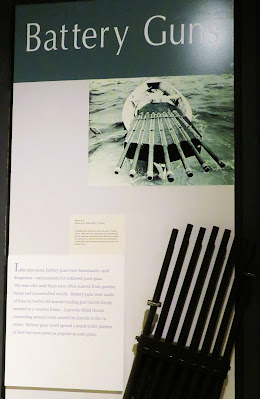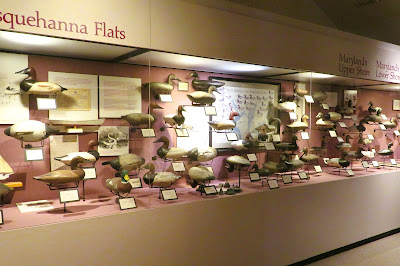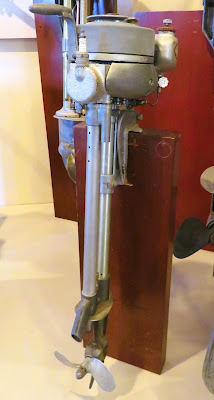…continuing with our tour of the Chesapeake Bay Maritime Museum which is located in St. Michaels Maryland. We were nearing the end of our family trip to explore part of the Delmarva Peninsula.
This
final post about our visit to the Museum will look at a variety of exhibits…in
no particular order.
The first photo shows a punt that's equipped with a punt gun… These were tools used in the commercial waterfowl hunting trade. Restaurants in the big cities not only craved oysters by the bushel, but also a steady supply of waterfowl for their clientele. The Chesapeake Bay area is a critical and massive stopover for migrating ducks, geese, etc.
Punts are
small flat-bottomed boats with a square bow.
They are used in smaller rivers and in shallow bodies of water. They’re propelled by pushing with a pole on
the river bed. Punt guns are oversized
smoothbore percussion guns that are far too big to fire from the shoulder so
they’re mounted at the front of the punt and could be aimed by the
shooter. Guns like this were charged
with huge amounts of gun powder and shot…and then were aimed at a flock of
water birds. When fired, a hundred or
more ducks could be harvested, just from one shot.
The second
photo is one of the results of punt guns being outlawed. To work around their inability to employ punt
guns, market hunters built ‘battery guns’.
Basically they consisted of 3 – 12 old muzzle loaders secured to a
wooden frame. A powder filled ‘trench’
connected to vents caused the barrels to fire in a series. With the spread of
gun barrels, they covered a wider area with shot pellets. However they were dangerous to operate…
In any
case, the use of punt guns or battery guns severely depleted the number of wild
waterfowl and by the 1860s most states had banned the practice. The Lacey Act of 1900 banned the transport of
wild game across state lines. Then a
series of Federal laws in 1918 outlawed market hunting altogether.
The
Chesapeake Bay Maritime Museum has an impressive collection of artifacts
related to water fowl hunting as a pastime and occupation. As shown above this collection includes
firearms and gunning skiffs but in addition there is a sizable collection of
decoys…backed up by sinkboxes, tools and clothing.
The
Museum’s large decoy collection includes working goose, duck, swan, and
shorebird decoys made by more than 70 regional makers…many of them rather
famous for their skills. This display is
part of the Museum’s long term exhibition “Stories from the Shoreline”.
Note: Not being a hunter I had to look up the
term ‘sinkbox’. It is a hunting blind
consisting of a weighted, partially submerged enclosure that can hold one or
more hunters. Sinkboxes are suspended
from a floating platform and are placed in calm water so the hunter can wait
for his opportunity with the waterline roughly at shoulder height. Since the early 1900s, sinkboxes have been
illegal in the USA
The first photo shows the “model shop” at the Museum. The volunteer Maritime Model Guild supports the Museum’s curatorial needs with exhibition models and building kits that are available at the Museum Store. The Guild also offers classes for building models from scratch. The Model Guild also hosts radio-controlled skipjack sailing races. The Museum’s extensive ship model collection numbers more than 300 vessels.
I suspect
that this handsome and detailed model of the “Peggy Stewart” was made by a
member of the Model Guild. The original “Peggy
Stewart” was a Maryland cargo vessel that, with its cargo of tea, was burned in
Annapolis Maryland on October 19, 1774. It’s
destruction was as a punishment for attempting to get around the boycott on tea
imports that had been imposed in retaliation for the British occupation of
Boston following that city’s “Tea Party”.
The burning of the “Peggy Stewart” in known as the “Annapolis Tea Party”.
Note: Incidentally, the most important cargo
aboard the “Peggy Stewart” was removed from the ship before she was
burned. That cargo consisted of 53 ‘indentured’
servants.
The first photo shows the tugboat “El Toro” after it had been acquired by the Chesapeake and Ohio Railroad and it had been renamed “Chessie”…and later “W.J. Harahan”. The “El Toro” was built in 1928 and spent many years of her life moving railroad car barges across Chesapeake Bay.
The
second photo shows the 12 foot high compound 2-cylinder steam engine the tug
boat was equipped with. This engine
produced 700 horsepower…just a fraction of the power needed for today’s
tugboats. As I’d mentioned, the Museum
covers a wide variety of Chesapeake Bay endeavors…
…and the
variety of displays at the Museum continues.
In this case it includes a collection of about 1500 historic and
contemporary paintings, prints and other artwork. Works by regional artists as well as
contemporary artists are featured along with posters, print advertisements and
detailed drawings.
I failed
to note the photographic artist who took this eye-catching aerial photo of a
creek or small river where it emptied into part of Chesapeake Bay. Nevertheless, I’d love to have the original
of this photo on my wall at home! Nature's designs are endless...
I do love
ship paintings…and this one is no exception.
This is a painting depicting the pungy “Geneva A. Kirwan” sailing along
the Bay. This vessel was built in
Madison Maryland in 1882. The painting
was completed in 1933 by Louis Feuchter.
Feuchter was born in 1885 and died in 1957. He was known for his maritime paintings and
he was quite prolific.
Many of
Feuchter’s paintings can be purchased for less than $1,000 with many in the
$500 range. The highest price for one of
his paintings was for a painting of the “Pungy Amanda F. Lewis”, which sold for
$4,312.
Note: Yes…I did have to look up the ship style
referred to as a ‘pungy’. Basically, a
pungy is a two-masted schooner that was used for oyster dredging in Chesapeake
Bay.
The “Stories from the Shoreline” exhibit also addresses the mass production and marketing of motorboats. This modest display of outboard motors caught my eye as I’m always looking for items that tie back to my former ‘work life’ in some way.
In this
case, that small outboard motor to the left center of the photo did tie back to
a former employer. The close-up photo of
the top of that little 7.5 HP “Sea King” outboard motor shows that it was
manufactured for and sold by Montgomery Ward.
The company sold Sea King outboard motors from 1933 until 1986. (I didn’t
join the company until 1987)
Primary
manufacturers of a variety of Sea King outboard motors included Gale, Clinton
and Chrysler Marine. Some discontinued Lockwood
(Evinrude/Outboard Motors Corporation) motors were also relabeled Sea
King. The same thing happened with some
Thor outboards. Apparently old/antique Sea
King outboard motors are quite collectable with a number of them for sale
on-line. Another company advertises that
they have replacement parts available.
This
rather worn vessel is a five-log Tilghman Canoe. It is the last of the 68 built by Robert
Lambdin of St. Michaels Maryland. These
canoes were used in the fisheries industry along the bay. This one was built in 1893 and it cost
$212.57 at the time. In 1910 this ‘canoe’
was converted to a powerboat by removing the centerboard and adding a propeller
shaft. It had been abandoned along the
shore of Chesapeake Bay for several years before it was rescued and stabilized
for the Museum.
…continuing
with my boating or boat theme. This is
the “Bessie Lee”, a 20 foot long Seaside Bateau that is located in the Small
Boat Shed at the Museum. This is a
two-sail periauger rig or “cat-yawl”. In
broad terms, a periauger or peroque is a shallow draft, often flat-bottomed
2-masted sailing vessel which also carried oars for rowing. These vessels were often created by digging
out a log, splitting it longitudinally and then adding at least one keel plank
between the halves.
Only
small vessels with a shallow draft could enter many of the inlets around the
bay. But these bateaus were used by
local merchants as well as blockade runners during the Revolutionary War. A family’s boat ca. 1850s may have looked
like this. Bateaus did come in varying
sizes depending on their planned use.
This is a
Smith Island Power Crabbing Skiff. Smith
Island watermen used similar boats to sail to their crabbing grounds where they
caught soft crabs using a dip net.
Originally these were sailing skiffs but engine-powered boats like this
began being used ca. 1907. Sailing
skiffs continued to be used in the commercial crab fishery until WWII.
After
retirement from the fishery business, this skiff was used for pleasure. She was found stored in a Pennsylvania barn
but she has been restored to her original configuration and paint colors. She was built ca 1925.
This
early cabin cruiser was built in 1926 by the Mathews Company in Port Clinton
Ohio. The original owner spotted it on
display at the Maryland Yacht Club in Baltimore and he paid $6,500 for it…a lot
of money back in 1926. Named the “Isabel”,
she was a ‘show boat’ so it came equipped with anchors, life rings, monogrammed
china, linen and silver. Some of those
artifacts are also on display at the museum.
The
family of the original owner spent almost 70 summers cruising the Chesapeake
Bay on “Isabel”. Her heirs were among
the founders of the Classic Yacht Club of America and they participated in
numerous rendezvous, parades and cruises.
With the exception of a new diesel engine, the boat retains most of its original
equipment and fittings. In 1995 the family
donated this classic 38 foot cruiser to the Chesapeake Bay Maritime Museum
I’ll end our tour of the Museum with a photo of a more traditional Chesapeake Bay boat. The 51 foot long “Old Point” was built in 1909. The builder used 7 pine logs pinned together and then hewn to shape to construct this vessel. She is a good example of the fleet of boats operating out of Hampton Virginia from the 1910s through the 1960s that were designed to dredge crabs during the winter.
From
December through March, captains and crews lived on their boats so they could
leave every morning and dredge for crabs all day. In the summer and fall, “Old Point” would
carry fish and oysters to packing houses or to market. The former owner of “Old Point”, Captain
Ernest Bradshaw, had to transition throughout the year…from fish, to oysters
and to crabs. Part of the Museum’s ‘floating
fleet’, “Old Point” was donated to the Museum by Mr. and Mrs. Richard C. DuPont
back in 1984.
And so
ends our tour of the Chesapeake Bay Maritime Museum. To learn more about the museum, its exhibits,
waterborne tours, hours of operation and entry fees, just go to Chesapeake
Bay Maritime Museum | Home Page (cbmm.org). We certainly enjoyed our experience at the
Museum!
Just
click on any of the photos to enlarge them…
Thanks
for stopping by for a visit!

















Es un genial museo. Te mando un beso.
ReplyDelete